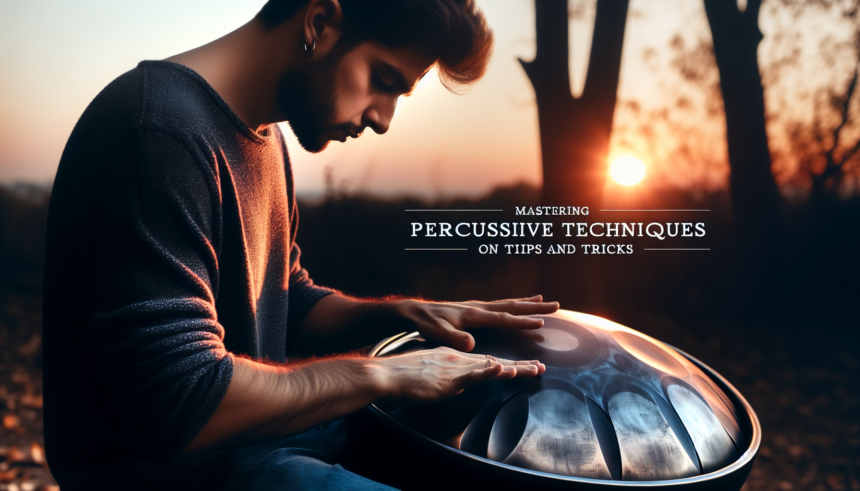The handpan is a mesmerizing instrument that produces ethereal sounds, capable of taking listeners on a calming, melodic journey. Although it may seem daunting to the uninitiated, mastering the handpan can be incredibly rewarding. This article delves deep into percussive techniques specific to the handpan, offering valuable tips and tricks to elevate your play and bring out the full expressive potential of this unique instrument.
Understanding Basic Handpan Percussion
Before exploring advanced techniques, it’s crucial to grasp the fundamentals of handpan percussion. The handpan consists of a central note, known as the Ding, surrounded by a series of tone fields arranged in a circle. Percussive techniques on the handpan primarily involve using different parts of your hand and fingers to strike these areas and produce distinct sounds.
- Flat Hand Strike: Using the flat of your hand to strike the Ding or tone fields produces a deeper, more resonant sound.
- Finger Tap: Tapping the tone fields gently with your fingers produces a lighter, sharper sound.
- Thumb Strike: Using your thumb to strike the tone fields can produce a different timbre, offering varied dynamics.
Advanced Handpan Percussion Techniques
1. Slap Technique
The slap technique is commonly used to add rhythmic complexity and intensity. This involves striking the handpan with a quick, snapping motion using the fingertips or thumb. Ensure your hand is relaxed to avoid tension and produce clear, sharp tones.
2. Muting or Damping
Muting or damping involves touching the tone fields lightly with your fingers or palm to stop the vibration, resulting in a muted sound. This technique can create rhythmic patterns and add dynamic contrast to your play. It’s particularly effective in creating stops and starts within a musical piece, adding a dramatic effect.
3. Ghost Notes
Ghost notes are subtle, softer notes played between the main beats. These can be produced by slightly tapping the handpan with minimal force, adding a layer of nuanced rhythm to your performance. They are essential in creating a flowing, continuous soundscape and adding texture to your music.
4. Heel-Toe Technique
This technique involves using the heel of your hand to strike the tone field followed quickly by the fingers or vice versa, creating a double hit. It’s an excellent way to build up speed and complexity in your rhythm. Practice this technique slowly at first, ensuring each note is clear before increasing the pace.
5. Flam Technique
The flam technique is borrowed from drumming and involves a quick succession of two hits, one slightly before the other, creating a ‘grace note’ effect. This adds a touch of flair to your rhythms and can be used for dramatic emphasis within a piece. Focus on maintaining a relaxed hand to execute this technique smoothly.
Combining Techniques for Dynamic Play
Mastering individual techniques is just the beginning; the true artistry lies in combining these techniques to create complex rhythms and varied soundscapes. Here are some tips for effectively integrating percussive techniques into your handpan performance:
- Practice Transitions: Smooth transitions between techniques are essential for maintaining the flow of your music. Practicing moving from one technique to another seamlessly will improve your overall performance.
- Use Dynamics: Vary the intensity and volume of your strikes to add emotional depth to your playing. Soft ghost notes contrasted with sharp slap techniques can create a compelling auditory experience.
- Explore Rhythmic Patterns: Experiment with different rhythmic patterns, combining heel-toe, flam, and slap techniques to craft unique compositions. Don’t be afraid to play with unconventional time signatures or syncopation to stand out.
- Improvise: Handpan music often benefits from a spontaneous, intuitive approach. Allow yourself to improvise and explore new techniques during your practice sessions. This can lead to discovering your own unique style.
Maintaining Your Handpan
Proper maintenance of your handpan is vital to preserve its sound quality and longevity. Here are some tips to keep your instrument in top condition:
- Regular Cleaning: Use a soft, dry cloth to wipe down your handpan after each use. Avoid using harsh chemicals, as they can damage the surface.
- Protection from Elements: Store your handpan in a dry, cool place. Extreme temperatures and humidity can affect its tuning and material integrity.
- Use a Case: Invest in a quality padded case for transportation to protect your handpan from dents and scratches.
- Check for Cracks: Regularly inspect your handpan for any cracks or signs of damage. Consult a professional for repairs if necessary.
Conclusion
Mastering percussive techniques on the handpan opens up a world of musical possibilities. From the basic flat hand strike to the advanced flam technique, each percussive method adds its own unique flavor to your sound. By practicing diligently and creatively combining these techniques, you can unlock the handpan’s full potential, creating enchanting rhythms and melodies that resonate deeply with listeners. Remember to maintain your instrument carefully to keep it in pristine condition. Happy playing!
FAQs
1. What is the best way to start learning handpan percussive techniques?
Start with basic strikes like the flat hand strike and finger tap. Once comfortable, gradually incorporate advanced techniques like the slap and flam. Practice regularly and consider taking lessons or watching tutorial videos for guided instruction.
2. How long does it take to master handpan percussive techniques?
Learning the basics can take a few weeks to a few months, depending on your practice frequency. Mastery of advanced techniques and seamless integration typically takes several months to years of consistent practice.
3. Can I damage my handpan by using percussive techniques?
When performed correctly, percussive techniques should not damage a well-made handpan. However, excessive force or improper technique can potentially cause dents or affect tuning. Always strive for controlled, accurate strikes.
4. Do I need special equipment to practice handpan percussion?
No special equipment is needed, but having a quality handpan stand can help position the instrument comfortably. Ensure you have a proper case for transportation and storage to protect the handpan when not in use.
5. How do I know if my handpan needs tuning?
If you notice any dissonance or that the notes don’t sound as clear as before, your handpan might need tuning. Handpans should be checked by a professional tuner annually or whenever you notice a significant change in sound quality.





